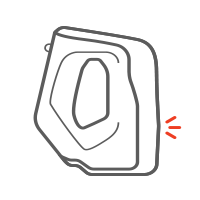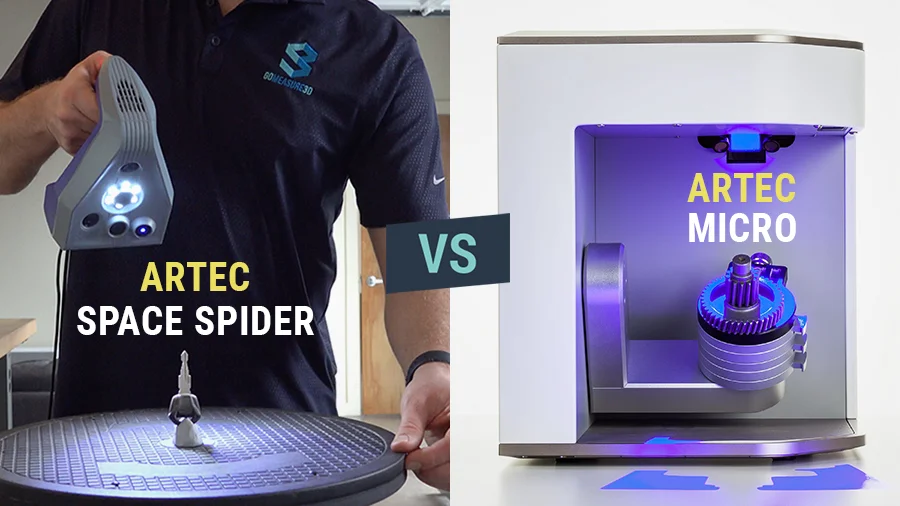
In our last In the Lab video, Art conducts a test with the Artec Space Spider handheld 3D scanner to see which 3D scanning accessory produces the best scans when scanning objects with challenging surfaces. Our findings reveal that using a 3D scanning spray is the way to go.
Here is the video if you are interested in watching it:
As a follow-up test, we want to see how the Artec Space Spider scan results compare to the Artec Micro. The testing procedures remain the same: We scan the same key and apply a thin coat of Aesub Orange 3D scanning spray before 3D scanning.
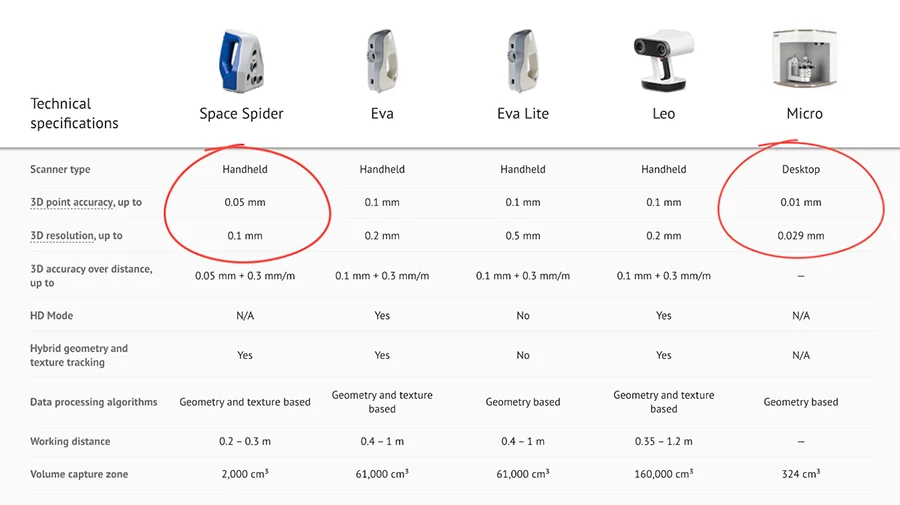
According to Artec’s website, the Artec Micro metrology-grade desktop 3D scanner is known for scanning extra small objects with high accuracy and resolution. It scans up to 0.01 mm (10 microns) accuracy.
You might be wondering:

Would the Artec Micro actually get better scan results than the Space Spider? How do the results compare?
If the Artec Micro produces better results, then under what situations would you select the Artec Space Spider over the Micro?
Let’s find out the answers to these questions.

Prefer To Watch a Video Instead?

Comparing The Results
Here are some side-by-side comparison shots between the Space Spider with the Micro. We magnified the 3D models to make it easier to see the differences.
Observations:
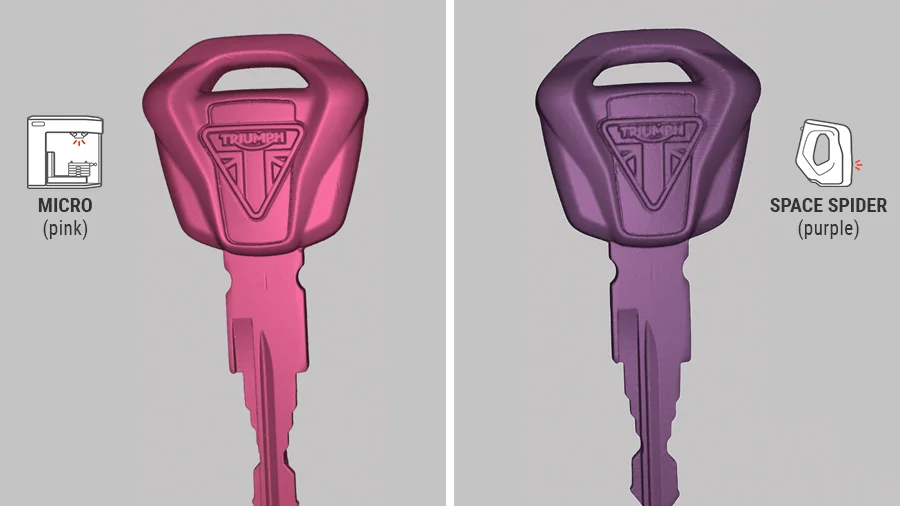
The logo on the Micro scan (left in pink) is sharper than the Space Spider (right in purple).
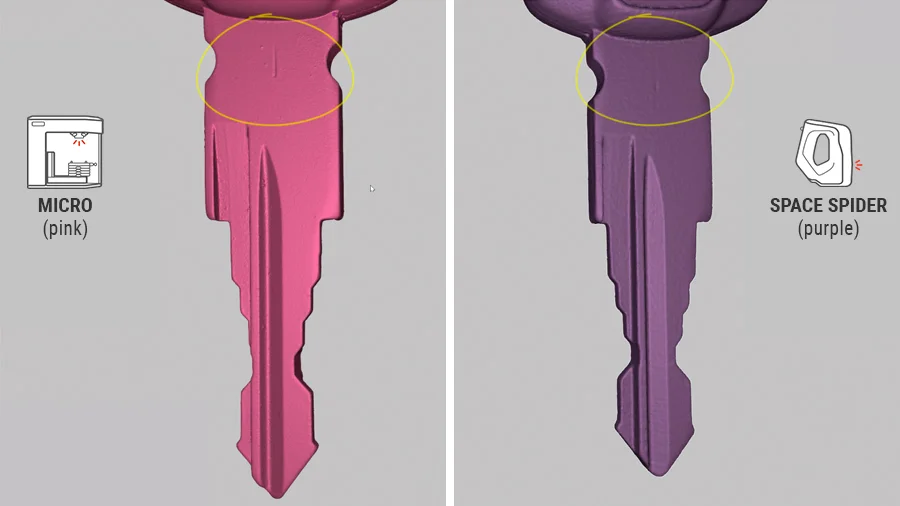
Faint marks and bumps are more evident on the Artec Micro 3D model.
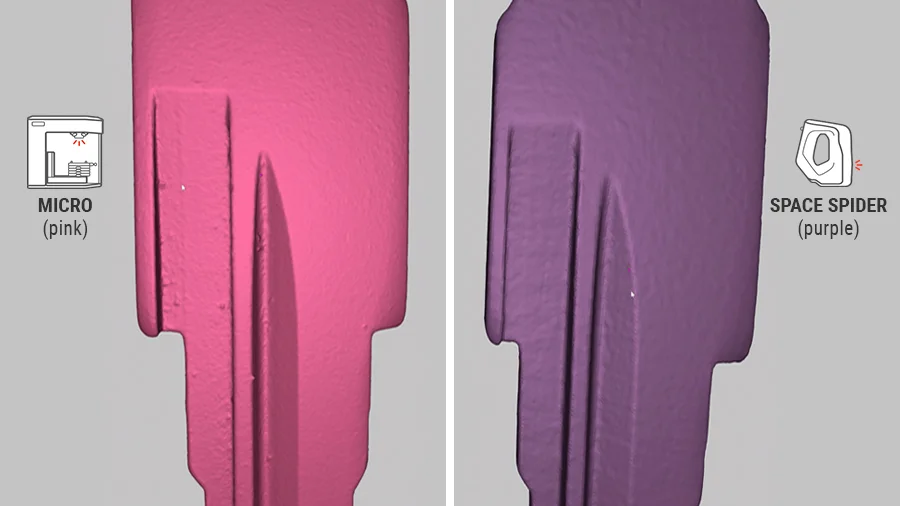
The Artec Space Spider 3D model captures a smoother surface while the Artec Micro reveals every imperfection.
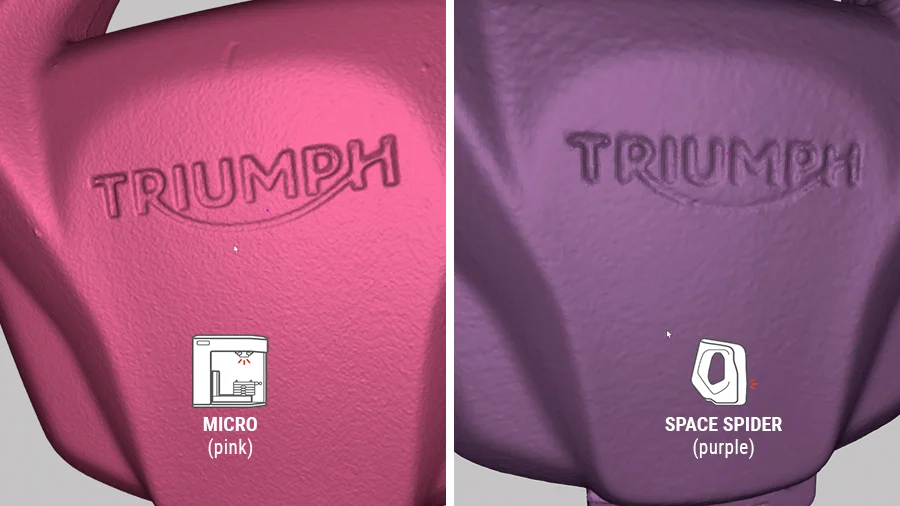
The word “Triumph” on the back of the key has more definition on the Micro scans than on the Space Spider scans.
Findings:
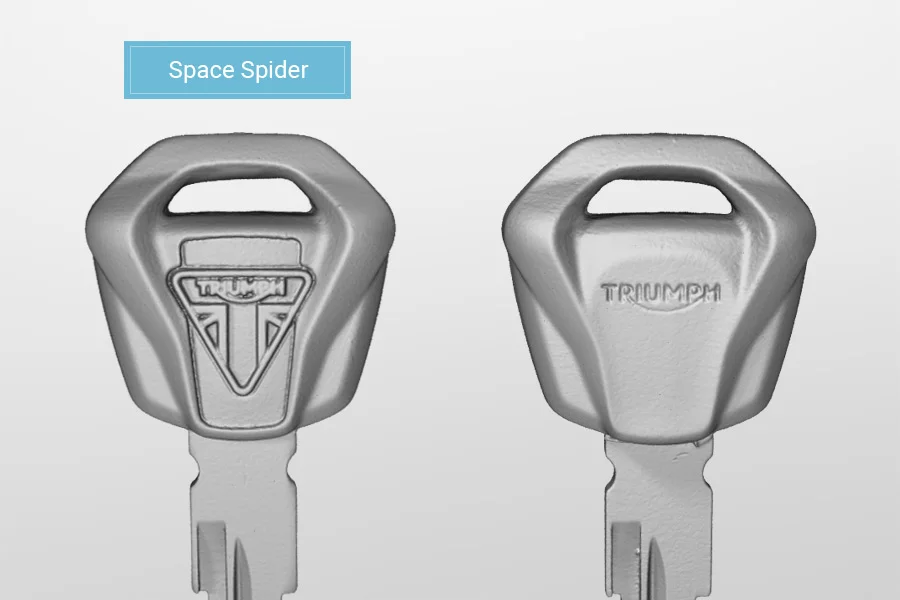
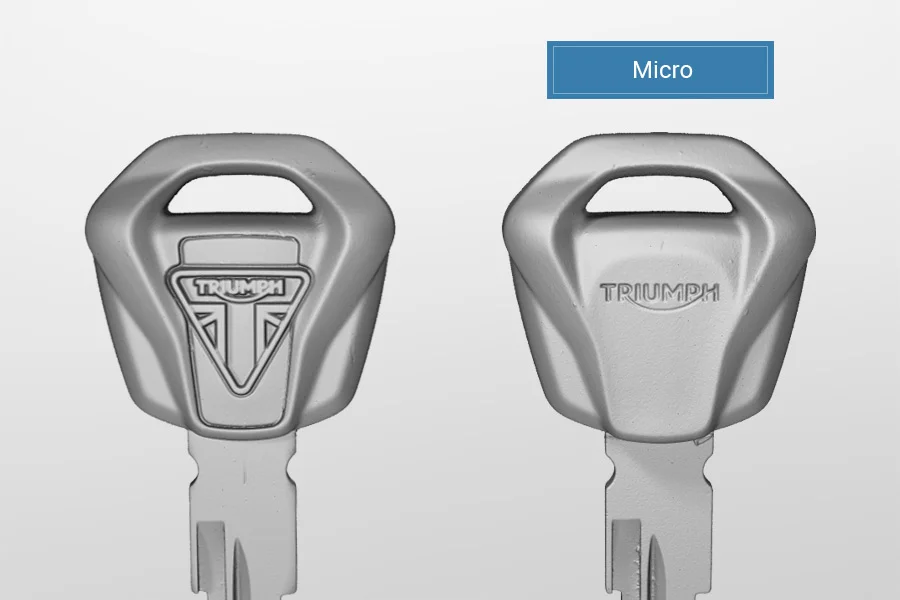
The Artec Space Spider does a pretty decent job of capturing the overall details of the key. However, if you want to capture every last detail of the key in high resolution and accuracy, the Artec Micro would be the choice.
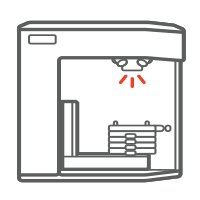
From our test, the Artec Micro captures even the minute details when scanning a small object like the key. So, when would you choose the Artec Space Spider over the Micro?
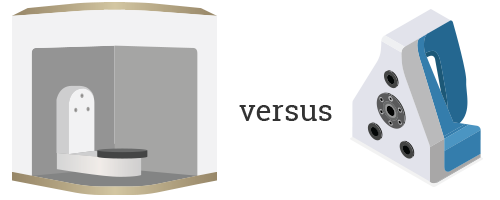
Artec Micro vs. Space Spider: Which 3D Scanner Is Right For You?
There are four questions you can ask yourself to determine which one is right for you.
-
Question #1: What is your object size?
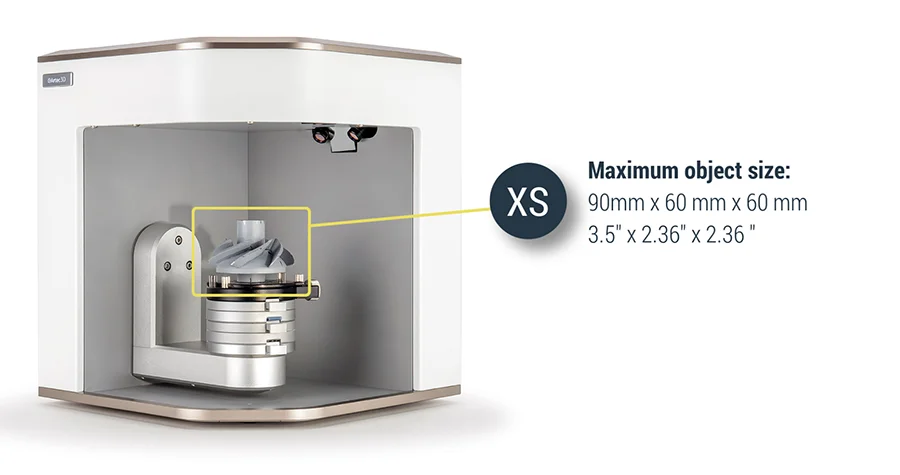
The Artec Micro’s strength is in scanning extra small objects. The maximum object size is 90mm x 60mm x 60mm (3.5” x 2.36” x 2.36”).
Because the Micro is a desktop 3D scanner, it has a threshold in terms of the size of the object it can scan.
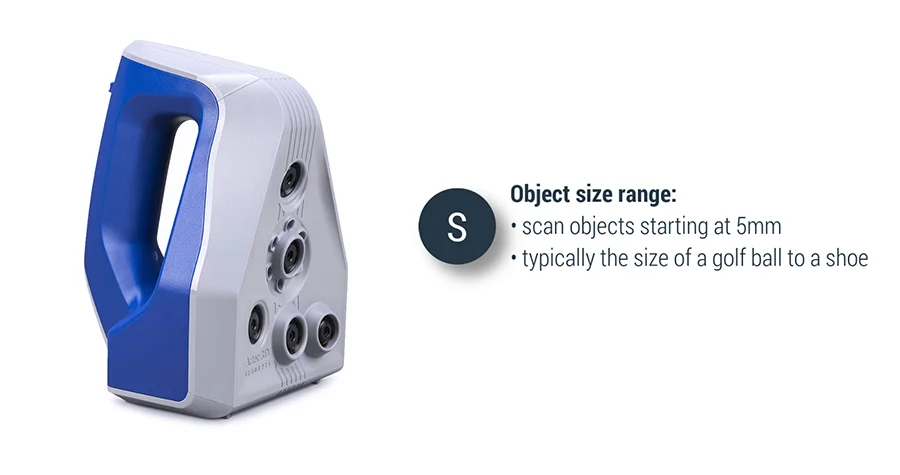
The Artec Space Spider is a handheld 3D scanner with a larger scanning volume. This makes it more versatile for 3D scanning objects of different shapes and sizes while still capturing the details. The sweet spot for this metrology-grade 3D scanner is scanning objects from 5mm to 30cm, which is typically the size of a golf ball to a shoe.
The Artec Space Spider doesn’t particularly have a limit to the size of objects it can scan. A Stegosaurus from the Denver Museum of Nature & Science was captured in 3D using the Space Spider. It has a massive size of 26 feet long and over nine feet tall!
-
Question #2: Do you need automation?
The Artec Micro is a fully automated desktop 3D scanner. Simply put the object in the device, press start, and let it do all the work for you. Its dual-axis rotation system creates high-quality 3D models in the fastest time with minimal effort.
This desktop scanner has a Smart scanning mode which allows it to capture the least amount of frames while getting the smallest file size possible.
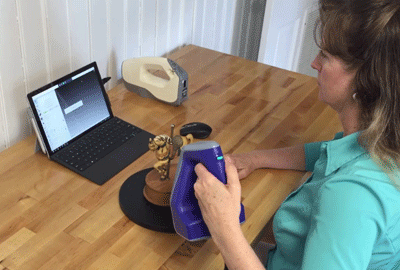
In contrast, The Artec Space Spider is a handheld device and it requires an operator to hold it in order to capture all the scans of a physical object during the capturing process. This characteristic gives it a convenience factor, as it can scan indoors as well as outdoors.
-
Question #3: Do you need high resolution and accuracy?
Space Spider Micro Resolution
0.1mm 0.029mm Accuracy
0.05mm 0.01mm If your application requires you to capture the details of extra small objects in the highest resolution and accuracy, the Artec Micro would be the choice. However, not all applications call for this level of quality, especially when the Artec Micro is more expensive than the Space Spider.

Money Saving Tip
To save money, consider choosing a 3D scanner with the technical specifications that match your application so you don’t end up paying for more than you really need—and afford. A scanner with a higher resolution and accuracy is often associated with a more expensive price tag.
In another test, we scanned a piece of broccoli using the Micro and the Space Spider. Compare the results in our article, Which 3D Scanner Is Best For Scanning Small Objects? The Artec Micro is the best 3D scanner for scanning small objects. The Artec Space Spider excels at scanning even medium-sized objects like this whitetail buck skull in high resolution and accuracy. -
Question #4: How portable do you need the 3D scanner to be?
If you travel frequently and require 3D scanning on the go, the Space Spider would be the best choice. This handheld 3D scanner comes with an optional battery pack that can power the scanner for up to 6 hours, allowing you to scan even in sites with no electricity.

The Artec Space Spider was taken to the Drimolen Main Quarry for research studies.
Photo source: Artec3DThe Artec Space Spider scanned more than 250 fragments of this 2-million-year-old hominid skull exactly how and where they were found. 3D scanning with this handheld 3D scanner involves no contact or damage to the fossil.

Recap
Here’s a quick comparison chart that summarizes our discussion on which 3D scanner is right for you. Each 3D scanner has its strengths. Choosing the right one largely depends on your use case and technical requirements.
|
|
|
|
|---|---|---|
Object Size |
small to medium | extra small |
Automation |
No | Yes |
Resolution (up to) |
0.1mm | 0.029mm |
Accuracy (up to) |
0.05mm | 0.01mm |
Portablility |
high (handheld) | low (desktop) |
If you have any questions, feel free to contact us and we’ll be happy to help!
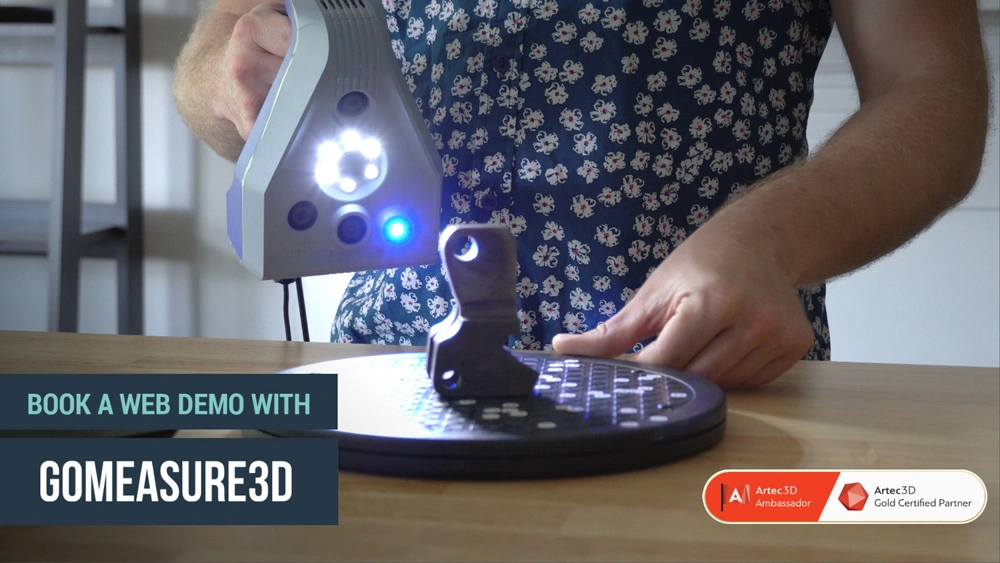
Instantly Book A Web Demonstration
Let us show you how 3D scanning can transform the way you work.
We can answer any questions you have on the technology right on the spot. Currently available for bookings anywhere in the US.
